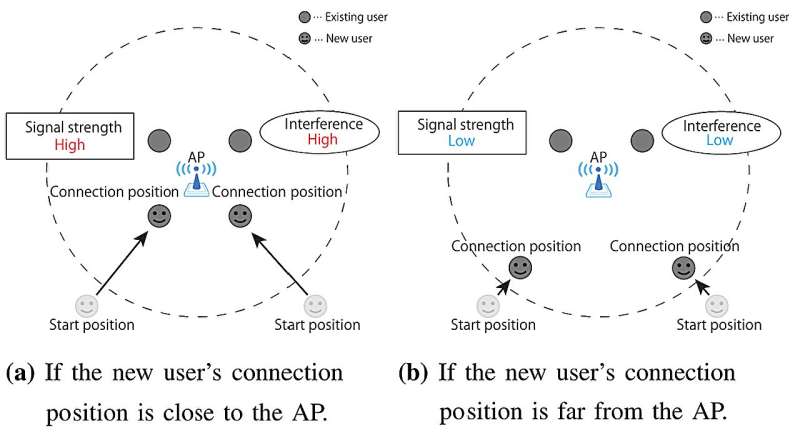A win-win approach: Maximizing Wi-Fi performance using game theory
Connectivity has become paramount in modern societies over the past two decades. With the immense rise in the number of laptops, tablets, and smartphones, most people nowadays expect to have access to free Wi-Fi in a variety of public and private spaces. Some common examples include airports, restaurants, and libraries, but even parks, trains, and subways offer Wi-Fi in some cities.
However, most wireless environments are based on the IEEE802.11 WLAN standards. Though undoubtedly an amazing feat of engineering, these standards suffer from inherent problems that can lower their performance for all users in a network.
For example, if a slow user joins a wireless local-area network (WLAN), their slow transmission rate can affect the throughput rate of other users, since users share the communication channels of the access point (AP, or “router”) by taking turns using it. Moreover, users can also interfere with each other when attempting to communicate with the AP, negatively impacting each other’s performance.
Scientists have come up with a few strategies to try to minimize the effects of these problems and improve the overall throughput of APs. Some of these methods are cooperative, meaning that users can be prompted by the AP to change their position in order to improve system throughput.
Though this is indeed a promising strategy, many existing techniques fail to simultaneously consider the interference between users and each user’s transmission rate. In turn, other techniques fail to account for the possibility that some users may be fixed, whereas others can move.
To address these limitations, a research team including Associate Professor Sumiko Miyata from Shibaura Institute of Technology (SIT) has developed a novel AP connection method using game theory. Their latest paper, which was authored by Yu Kato from SIT and co-authored by Jiquan Xie and Tutomu Murase from Nagoya University, is published in the IEEE Open Journal of the Communications Society.
Game theory is a branch of mathematics that mainly deals with the analysis of decisions and decision-making, especially within clearly defined frameworks (“games”) with rules, possible actions, and agents. Usually, the goal in game theory analysis is to identify optimal strategies.
“For wireless communication environments where multiple users exist and must be considered, game theory is one of the most suitable theories to use for analysis,” explains Dr. Miyata. “In the approach proposed in our paper, the user position that maximizes system throughput is determined using what’s known as a ‘potential game,’ which is a type of model in game theory.”
The developed potential game model, whose objective function is to maximize system throughput, condenses the incentives for all users into a single function. In this way, and unlike previous methods, the impact of the position of new users joining a WLAN on existing users is considered. Moreover, the new approach also takes into account inter-user interference by calculating the probabilities of packet collisions.
The researchers tested their proposed AP connection strategy, which was directly based on their potential game model, by comparing it with previous AP connection methods. They analyzed the resulting AP throughput for each method in a wide variety of scenarios involving different user positions. In this way, they proved that their proposed strategy almost always resulted in a throughput improvement compared to other techniques, with the improvement in system performance reaching up to 6% in some cases.
Although having a router prompt existing or new users to move around is not feasible in every situation, the proposed strategy could find a home in certain environments.
“Our method could be a potential option for Wi-Fi services in classrooms and libraries due to their location-free characteristics and low human traffic,” explains Dr. Miyata. “The Wi-Fi system would calculate the optimal user positions based on their locations to enhance overall throughput and encourage them to take cooperative action, motivated by a desire to increase their own throughput as well.”
Overall, methods like the one developed in this study are significant, given the innumerable number of Wi-Fi-enabled devices present today.
“AP systems should be efficient regarding the use of their network resources. The proposed technique is an important technology for realizing smart cities, where everything is connected to the internet,” concludes Dr. Miyata
More information:
Yu Kato et al, AP Connection Method for Maximizing Throughput Considering Moving User and Degree of Interference Based on Potential Game, IEEE Open Journal of the Communications Society (2024). DOI: 10.1109/OJCOMS.2024.3380515
Shibaura Institute of Technology
Citation:
A win-win approach: Maximizing Wi-Fi performance using game theory (2024, April 22)
retrieved 23 April 2024
from https://techxplore.com/news/2024-04-approach-maximizing-wi-fi-game.html
This document is subject to copyright. Apart from any fair dealing for the purpose of private study or research, no
part may be reproduced without the written permission. The content is provided for information purposes only.

Comments are closed